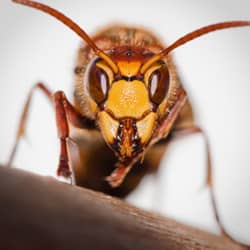The end of summer is just about upon us. Although it doesn’t seem possible; sadly, the calendar does not lie. If this realization causes you to think that you had better be scheduling and prepping for an end of summer barbecue, then don’t forget to think about yellow jackets when you’re making your list of things to do in preparing for it. No, I don’t mean little yellow jackets for everyone to wear; I mean the buzzing stinging type!
Yellow jackets are a formidable foe when it comes to claiming your property. These small yet aggressive pests have the ability to sting multiple times. And they are not just passively building a nest and buzzing around pollinating; they will actually look for and attack anything that they perceive as a threat to their nest.
Yellow jackets are social insects that live and work together for the good of their colony. Their colonies can be quite large, sometimes growing to upwards of 4,000 members! These yellow and black buzzing and stinging flyers are about 3/8th to 5/8th of an inch in size. They are predatory and scavenging omnivores, which means that they eat fruit, nectar, meat, flies, bees, and sweet drinks.
Nests of yellow jackets are quite frequently made in or on the ground. Their colonies can be found in places like between garden steps, under porches and stairs, in tree stumps, sidewalk cracks, and rodent burrows, around railroad ties or other landscaping ties. They also build low aerial nests in low-hanging branches or up in the corners of buildings. These nests are made of wood fiber that they make by chewing wood into a paper-like pulp. Their nests are usually a round or ball shape, although they will make it fit the size that is available to them.
Believe it or not, these wasps, yes they are technically considered a wasp, are considered an agriculturally beneficial pest in some situations. They are pollinators, and they eat many grubs, flies, and other agriculturally harmful insects. But, when they build their nests too close to our homes, properties, or businesses, they need to be removed.
Never ever try to remove a yellow jacket nest on your own. Yellow jackets will attack anything that they think is a threat to their colony, and they have a unique ability to emit and receive an ‘alarm pheromone’ that ‘rally the troops’ to attack when any of them emit it. This is why so many times when we stumble upon a yellow jacket nest we receive multiple stings before the encounter is over.
Here at All-American Pest Control, our team of pest control experts have been specially trained in the treatment and removal of yellow jacket nests as well as preventative steps to keep them away for good. We don’t want our family, friends, and neighbors to have to deal with this aggressive pest. If you have a yellow jacket nest that is too close for comfort, or you suspect that there may be one nearby, give us a call today and schedule your free home evaluation and let our team start protecting your Tennessee property today!
 1426 Reviews
1426 Reviews


